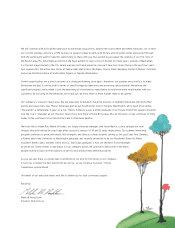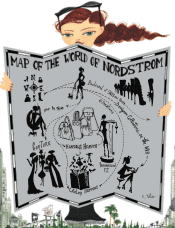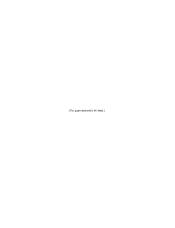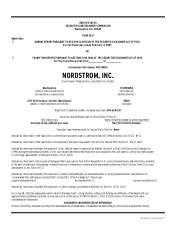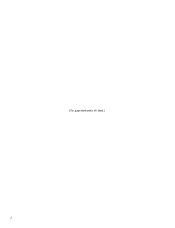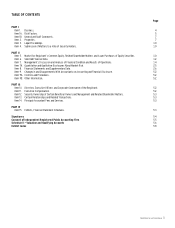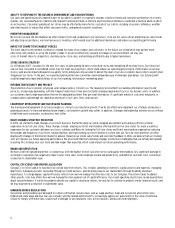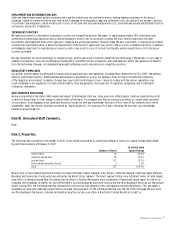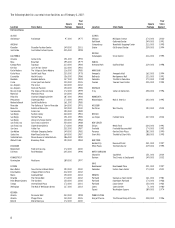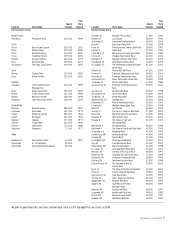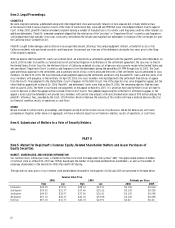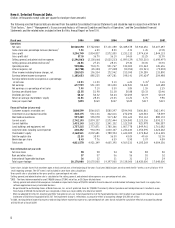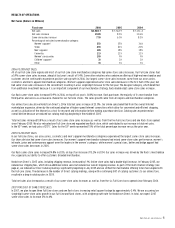Nordstrom 2006 Annual Report Download - page 24
Download and view the complete annual report
Please find page 24 of the 2006 Nordstrom annual report below. You can navigate through the pages in the report by either clicking on the pages listed below, or by using the keyword search tool below to find specific information within the annual report.6
ABILITY TO RESPOND TO THE BUSINESS ENVIRONMENT AND FASHION TRENDS
Our sales and operating results depend in part on our ability to predict or respond to changes in fashion trends and consumer preferences in a timely
manner. Any sustained failure to identify and respond to emerging trends in lifestyle and consumer preferences could have a material adverse affect
on our business. Consumer spending at our stores may be affected by many factors outside of our control, including consumer confidence, weather
and other hazards of nature that affect consumer traffic, and general economic conditions.
INVENTORY MANAGEMENT
We strive to ensure the merchandise we offer remains fresh and compelling to our customers. If we are not successful at predicting our sales trends
and adjusting our purchases, we may have excess inventory, which would result in additional markdowns and reduce our operating performance.
IMPACT OF COMPETITIVE MARKET FORCES
The retail industry environment continues to change for many of our vendors and customers. In the future, our competition may partner more
effectively with vendors to serve the market’s needs. If we do not effectively respond to changes in our environment, we may see
a loss of market share to competitors, declining same-store sales, and declining profitability due to higher markdowns.
STORE GROWTH STRATEGY
As of February 2007, our plans for the next five years include opening 26 new or relocated stores and remodeling 69 existing stores. Our future net
sales at new, relocated or remodeled stores may not meet our projections, which could reduce our operating performance. Performance in our new
stores could also be impacted based on our ability to hire employees who are able to deliver the level of service customers have come to expect when
shopping at our stores. In the past, our expected opening dates have sometimes been delayed because of developer plan delays. Our future growth
could be negatively impacted by delays to our store opening, relocating or remodeling plans.
INFORMATION SECURITY AND PRIVACY
The protection of our customer, employee, and company data is critical to us. The regulatory environment surrounding information security and
privacy is increasingly demanding, with the frequent imposition of new and constantly changing requirements across our business units. In addition,
our customers have a high expectation that we will adequately protect their personal information. A significant breach of customer, employee, or
company data could damage our reputation and result in lost sales, fines, and lawsuits.
LEADERSHIP DEVELOPMENT AND SUCCESSION PLANNING
The training and development of our future leaders is critical to our long-term growth. If we do not effectively implement our strategic and business
planning processes to train and develop future leaders, our long-term growth may suffer. In addition, if unexpected leadership turnover occurs without
established succession plans, our business may suffer.
MULTI-CHANNEL STRATEGY EXECUTION
In 2005, we started to make changes in our Direct business that better align our online shopping environment and catalog with the customer
experience in our Full-Line stores. These changes include: aligning our Direct merchandise offering with our Full-Line stores to create a seamless
experience for our customers between our stores, catalogs and Web site, linking the Full-Line stores and Direct merchandise organization; reducing
the number and frequency of our Direct catalog mailings; and transitioning our Direct inventory system onto our Full-Line store platform, all while
dealing with changes in the Internet market in general. Based on our online sales trends and customer feedback in 2006, we believe that our strategy
shift will improve our future operating performance. We also found that the technology changes will be more challenging than we initially anticipated.
Executing this strategy may cost more and take longer than expected, which could impact our future operating performance.
BRAND AND REPUTATION
We have a well-recognized brand that is synonymous with the highest level of customer service and quality merchandise. Any significant damage to
our brand or reputation may negatively impact same-store sales, lower employee morale and productivity, and diminish customer trust, resulting in
a reduction in shareholder value.
CAPITAL EFFICIENCY AND PROPER ALLOCATION
Our goal is to invest capital to maximize our overall long-term returns. This includes spending on inventory, capital projects and expenses, managing
debt levels, managing accounts receivable through our credit business, and returning value to our shareholders through dividends and share
repurchases. To a large degree, capital efficiency reflects how well we manage the other key risks to our Company. The actions taken to address
other specific risks may affect how well we manage the more general risk of capital efficiency. Our recent operating results have raised expectations
about our performance. If we do not properly allocate our capital to maximize returns, we may fail to continue to produce similar financial results and
we may experience a reduction in shareholder value.
HUMAN RESOURCE REGULATIONS
Our policies and procedures are designed to comply with human resource laws such as wage and hour, meal and rest period, and commissions.
Federal and state wage and hour laws are complex, and the related enforcement is increasingly aggressive, particularly in the state of California.
Failure to comply with these laws could result in damage to our reputation, class action lawsuits, and dissatisfied employees.


